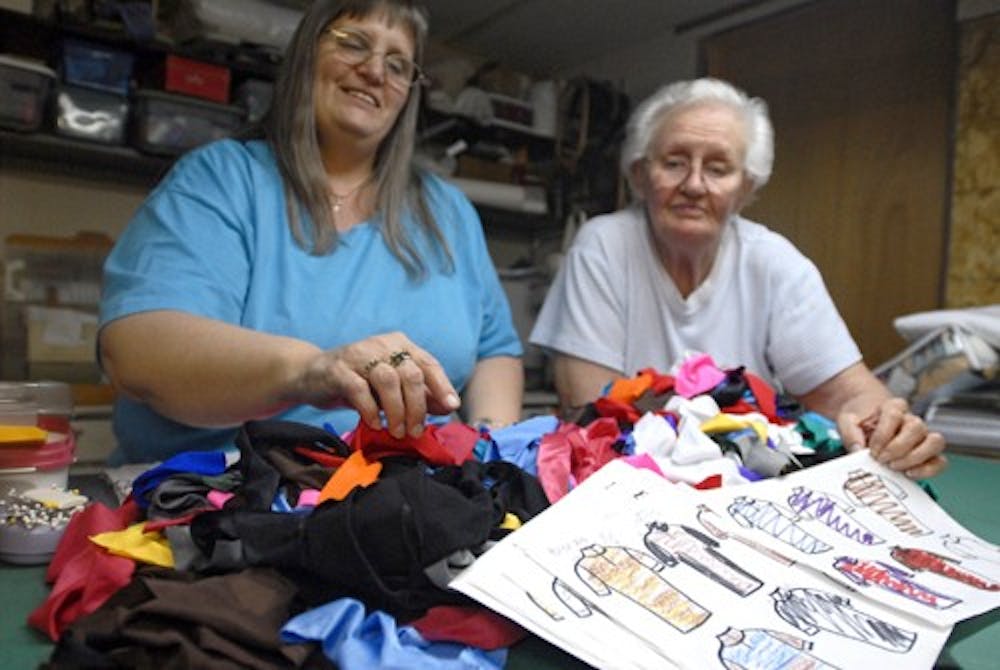MARTINSVILLE – From atop the bleachers at Bill Armstrong Stadium, thousands of fans that attend the Little 500 bike races can see how well their teams are performing.\nBut for some race spectators, what the riders are doing is far less important than what they are wearing.\n“We worry about the shirts,” said Karla Kindred, a woman living in Martinsville who has sewn all the Little 500 jerseys for more than 15 years. “Of course we don’t want to see anybody get hurt, but we don’t want to see our shirts get hurt, either.”\nSince the early 1990s, Kindred and friend Susan Mannina have had their hands in every single race. \nMannina, who lives in Indianapolis, orders all the Lycra material, designs all the jerseys and cuts all the fabric. Once she is finished, Karla Kindred’s husband Dan Kindred picks up the material and brings it to his wife who sews the jerseys together.\n“She buys them in big pieces and cuts them up, and I put them back together,” Karla Kindred said while sifting through scrap pieces of fabric in her home workroom Wednesday night.\nThe two are proud of their small operation.\n“It’s really a cottage industry,” Mannina said. “It’s very old fashioned. But it works.”\nMannina and Karla Kindred met through Kindred’s mother Kittie Butler, a seamstress who frequently worked with Mannina. Butler taught her daughter how to sew.\nWhen Mannina and her friend Rose Parli started a jersey manufacturing business, they contacted Kindred to sew their material together. One year the three made jerseys for a couple of independent Little 500 teams, but within a few years the IU Student Foundation contracted the three women to make all the Little 500 jerseys.\nFrom that point, the women have had the job. Parli has since moved to South Carolina, but Kindred and Mannina carry on the tradition.\n“We enjoy it because we can do it on our time frame,” Mannina said.\nThere are a few requirements, though. \nKindred and Mannina have to make eight jerseys per color combination – four larges for the men and two larges and two mediums for the women. One set of jerseys must be yellow for the defending champions, one must be green for the pole sitters and one must be white for the series champions. All in all, they make 280 jerseys. \nOther than that, “they don’t put any restrictions on us,” Mannina said. “The way we’ve got it worked out is that they let us do the colors, and we do what we can with the fabric we’re able to buy.”\nThe pair starts working on the jerseys in September of the year before the race. Mannina contacts a Lycra broker living in New York City and orders enough fabric for the jerseys. She’ll finish preparing a pack of about five jerseys and hand them over to Kindred, who, with the help of her mother, finishes the job. Their work must be finished in time for Little 500 Qualifications at the end of March. \n“It gets to be kind of a push at the end of January, early February,” Kindred said. “We push to get them all done, but inevitably, we do.”\nThe women make the jerseys at home in their spare time. Both hold full-time jobs. Kindred works at a jersey-making shop in Martinsville and Mannina works at the Christian Theological Seminary in Indianapolis.\nMannina estimated she spends approximately 100 hours preparing the jerseys. Kindred said she probably spends twice as long.\n“I’ve gotten a lot of sleepless nights, a lot of sleepless weeks,” Kindred said. \nIn addition to the time they spend at the cutting table and the sewing machine, the women try to make it out to watch the race from time to time. Neither had been to the race before making the jerseys. Kindred admitted watching the Little 500 for the first time was a little weird.\nShe’s used to seeing all the jerseys on her worktable, not on the backs of Little 500 riders.\nAs a seamstress, Kindred works with most of her jerseys facing inside out. \n“Here I’ve worked on these and seen them mostly wrong side out,” she said. “Then (at the race) when I see them turned right side in, it’s completely different.”\nThen again, the race is all about perspective.
Sewing Away
Two women put personal touch on each of 280 Little 500 jerseys

Get stories like this in your inbox
Subscribe





